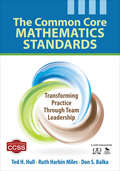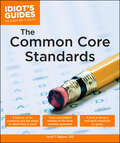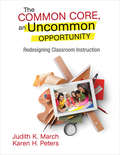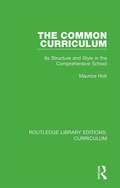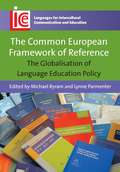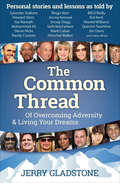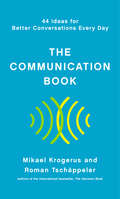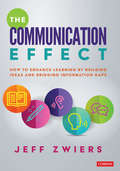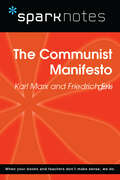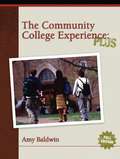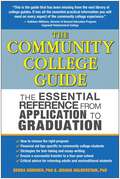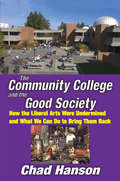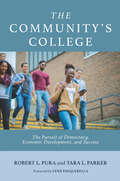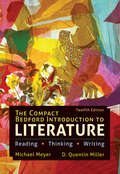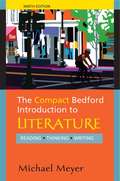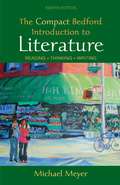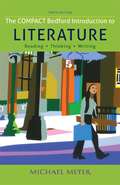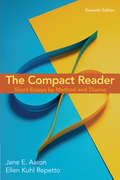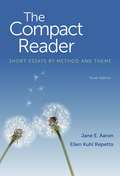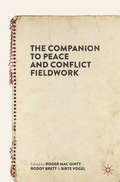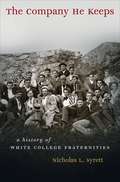- Table View
- List View
The Common Core Mathematics Standards: Transforming Practice Through Team Leadership (Corwin Mathematics Ser.)
by Don S. Balka Ted H. Hull Ruth Harbin MilesTransform math instruction with effective CCSS leadership The Common Core State Standards for mathematics describe the “habits of mind” that teachers should develop in their students without which the content standards cannot be successfully implemented. This professional development resource helps principals and math leaders grapple with the changes that must be addressed so that teachers can implement the practices required by the CCSS. Included are: A clear explanation of the CCSS for Mathematical Practice Techniques to help leadership teams collaboratively implement and maintain the new standards A proficiency matrix with examples of instructional strategies for helping students reach competency in each standard
The Common Core Standards (Idiot's Guides)
by Jared T. BighamIn an effort to ensure that all U.S. students are equally prepared for college and careers, new academic standards for Kindergarten through 12th grade have been established and adopted by nearly every state. Idiot's Guides: The Common Core Standards helps parents, students, teachers, and administrators understand the details of this historic initiative. An outline of what makes these standards different from previous statewide standards; a grade level breakdown of the standards for English, math, and other subject areas; details of how students' learning will change under the Common Core; ways parents can help students at home; information on the assessments that students will take; and answers to the most commonly asked questions are all included.
The Common Core, an Uncommon Opportunity: Redesigning Classroom Instruction
by Judith K. March Karen H. PetersBecause the Common Core requires bold action Why The Common Core, an Uncommon Opportunity? Why now? Because it tackles a largely overlooked component of implementation: how to redesign your instructional delivery system, K-12. And you’ll have to; if you don’t, you’ll be subject to the very same failure and frustration so many other districts and schools are experiencing. What’s more, March and Peters describe how to integrate 21st Century Skills at the very same time. It will help district leaders Develop structured, consistent, and organized teaching and learning practices Make district-wide infrastructure adjustments for sustained reform Use best practices for sustained achievement and continuous curriculum review
The Common Curriculum: Its Structure and Style in the Comprehensive School (Routledge Library Editions: Curriculum #18)
by Maurice HoltOriginally published in 1978. This book presents how the potential of the comprehensive school could be realized by bringing unity and coherence to its curriculum and organization. Among the subjects considered are value judgments and curriculum design; faculties and the organization of learning; subjects and options; the sixth form; and the timetable as an enabling device. This book goes beyond the prevalent considerations of the time to examine the relationship between educational theory and practice, and the underlying issues of how a rationale of curriculum may be determined and the involvement of teachers in school-focused curriculum development. An appendix considers the curriculum and timetable structure of Sheredes School in Hertfordshire, a new comprehensive school set up in 1969.
The Common European Framework of Reference
by Lynne Parmenter Michael ByramThe Common European Framework of Reference for Languages was published a decade ago and has been influential ever since, not only in its European 'home' but throughout the world. This book traces the processes of the influence by inviting authors from universities and ministries in 11 countries to describe and explain what happened in their case. There are everyday factors of curriculum development - which sometimes include coincidence and happenstance - and there are also traditions of resistance or acceptance of external influences in policy-making. Such factors have always existed in bilateral borrowing from one country to another but the CEFR is a supra-national document accessible through globalised communication. The book is thus not only focused on matters of language education but is also a Comparative Education case-study of policy borrowing under new conditions.
The Common Thread: Of Overcoming Adversity & Living Your Dreams
by Jerry GladstonePersonal stories from entertainers, athletes, and other successful people on how they overcame setbacks—and advice on how you can, too. What makes the difference between the desire for success and real success? Learn from some of the world&’s most successful people—including Mark Cuban, Sylvester Stallone, Bill O&’Reilly, Montel Williams, Stevie Nicks, Snoop Dogg, Gloria Gaynor, Randy Couture and others, in this unique collection of stories and advice. They may be Academy or Grammy award winners, Super Bowl or World Series champions, Rock and Roll Hall of Fame legends, best-selling authors, or even billionaires—but that doesn&’t mean they have never faced obstacles and challenges. In fact, it was their ability to overcome the inevitable hardships of life that kept them on the path to achievement. Here, you can learn about their experiences and discover the &“common thread&” that successful people share. Stop letting your circumstances, your lack of resources, or your past define who you are or what you can become. Find proven strategies, insights, wisdom and perspective—in a guide that helps you master new skills and habits with practical, helpful &“do it daily&” tips you can implement immediately. &“With his winning attitude and the many stories Jerry has shared in his book, there is no doubt we can all benefit and be empowered to reach our fullest potential&” —Jim Davis, Emmy award-winner and creator of Garfield
The Communication Book: 44 Ideas For Better Conversations Every Day
by Roman Tschäppeler Mikael KrogerusMikael Krogerus and Roman Tschäppeler have tested the 44 most important communication theories and distilled them in book form, alongside clear and entertaining illustrations. Want better conversations? Ask open-ended questions that have no right or wrong answers—make your partner feel brilliant. Want better meetings? Ban smartphones, use a timer, and make everyone stand up. Want better business deals? Focus on the thing, rather than the person; on similarities, rather than differences; and on good outcomes, rather than perfect ones. Whether you want to present ideas more clearly, improve your small talk, or master the art of introspection, The Communication Book delivers, fusing theoretical knowledge and practical advice in a small but mighty package. With sections on work, the self, relationships and language, this book is indispensable for anyone who wants to improve what they say, and how they say it.
The Communication Effect: How to Enhance Learning by Building Ideas and Bridging Information Gaps
by Jeff ZwiersThe &“communication effect&” is what happens when we saturate our classrooms with authentic communication, which occurs when students use language to build up ideas and do meaningful things. For starters, authentic communication deepens and increases language development, learning of content concepts and skills, rigor and engagement, empathy and understanding of others&’ perspectives, agency and ownership of core ideas across disciplines, and social and emotional skills for building strong relationships. And these are just the starters. With The Communication Effect, Dr. Jeff Zwiers challenges teachers in Grades 3 and up to focus less on breadth and more on depth by grounding instruction and assessment in authentic (rather than pseudo-) communication. This book provides: Ideas for cultivating classroom cultures in which authentic communication thrives Clear descriptions and examples of the three features of authentic communication: 1. building up key ideas (claims and concepts); 2. clarifying terms and supporting ideas; and 3. creating and filling information gaps Over 175 suggestions for using the three features of authentic communication to enhance twenty commonly used instructional activities across disciplines Additional examples of not-so-commonly-used activities that embody the three features Suggestions for improving four different types of teacher creativity needed to design effective lessons, activities, and assessments that maximize authentic communication Our students deserve to get the most out of each minute of each lesson. Authentic communication can help. As you read The Communication Effect and apply its ideas, you will see how much better equipped and inspired your students are to grow into the amazing and gifted people that they were meant to become.
The Communication Effect: How to Enhance Learning by Building Ideas and Bridging Information Gaps
by Jeff ZwiersThe &“communication effect&” is what happens when we saturate our classrooms with authentic communication, which occurs when students use language to build up ideas and do meaningful things. For starters, authentic communication deepens and increases language development, learning of content concepts and skills, rigor and engagement, empathy and understanding of others&’ perspectives, agency and ownership of core ideas across disciplines, and social and emotional skills for building strong relationships. And these are just the starters. With The Communication Effect, Dr. Jeff Zwiers challenges teachers in Grades 3 and up to focus less on breadth and more on depth by grounding instruction and assessment in authentic (rather than pseudo-) communication. This book provides: Ideas for cultivating classroom cultures in which authentic communication thrives Clear descriptions and examples of the three features of authentic communication: 1. building up key ideas (claims and concepts); 2. clarifying terms and supporting ideas; and 3. creating and filling information gaps Over 175 suggestions for using the three features of authentic communication to enhance twenty commonly used instructional activities across disciplines Additional examples of not-so-commonly-used activities that embody the three features Suggestions for improving four different types of teacher creativity needed to design effective lessons, activities, and assessments that maximize authentic communication Our students deserve to get the most out of each minute of each lesson. Authentic communication can help. As you read The Communication Effect and apply its ideas, you will see how much better equipped and inspired your students are to grow into the amazing and gifted people that they were meant to become.
The Communist Manifesto (SparkNotes Philosophy Guide)
by SparkNotesThe Communist Manifesto (SparkNotes Philosophy Guide) Making the reading experience fun! SparkNotes Philosophy Guides are one-stop guides to the great works of philosophy–masterpieces that stand at the foundations of Western thought. Inside each Philosophy Guide you&’ll find insightful overviews of great philosophical works of the Western world.
The Community College Baccalaureate: Emerging Trends and Policy Issues
by Deborah L. Floyd Michael L. Skolnik Kenneth P. Walker* Is the conferring of baccalaureate degrees by community colleges a solution to increasing access to and capacity in higher education?* Will the conferring of baccalaureate degrees restrict open access to, and imperil the existing mission of, community colleges?* What are the models and alternative methods of delivery? What are the implications?Breaking away from their traditional mission of conferring only associate degrees and occupational credentials, an increasing number of community colleges have begun seriously to explore and, indeed, in some U.S. states and Canadian provinces, to actually implement offering and conferring bachelor’s degrees. Some leaders see these changes as a natural extension of community colleges’ commitment to access, while others view their awarding of baccalaureate degrees as inappropriate and threatening the basic core values of this unique sector of higher education. This has become a "hot" and controversial topic, not only among community college and university leaders, but also among policy makers, business leaders and students concerned with issues of access, cost and the structure and purposes of post-secondary education. This book analyzes the emerging trend of the community college baccalaureate degree in the United States and Canada in order to contribute to the development of policy. The authors aim to describe, document, and explain this significant development in higher education. They present the background, examples of practice and different models of delivery, develop a common terminology to facilitate discussion, give voice to the views of proponents and critics alike, and include a comprehensive bibliography and set of resources. This book is intended as a catalyst for dialog, action and further research on this critical and emerging trend. It is essential reading for leaders of community colleges, for administrators and planners in higher education concerned with issues of access and articulation, and anyone in public policy grappling with demographic trends and society’s need for educated citizens able to meet the challenges of the future.
The Community College Experience: PLUS Edition
by Amy BaldwinFinally, a book that knows what community college students need! The Community College Experience: PLUS is the only book on the market truly written for community college students. This book will help students navigate into this environment and achieve success in school and in life by addressing central topics and concerns. The text encourages critical thinking throughout the chapters with embedded chapter exercises, case scenarios, research ideas, PLUS more! Other features include: PLUS Model shows how to integrate personality styles with learning styles for greater success Community college student profile From College to University and From College to Career features Chapter exercises that require higher-order thinking Research It Further Ideas that allow students to think about topics beyond the chapter's focus VARK Learning Styles Application providing tips for applying the chapter's material to four different learning style preferences Additional Support - in and out of the classroom: For instructors and students alike, we encourage you to visit our Student Success Supersite. This valuable resource is at www.prenhall.com/success Features include: Majors Exploration Career Advice Web Links Tips from Successful Students Student Bulletin Boards Faculty Resources
The Community College Guide: The Essential Reference from Application to Graduation
by Joshua Halberstam Debra GonsherBookstore shelves are crowded with books offering advice to college students, yet—astonishingly—none of these books offer needed advice to the majority of college students in the United States … those attending community college. Of the approximately 21 million full- and part-time college students, 11 million attend community colleges. The Community College Guide aims to help fill this huge gap. The authors of this book have decades of experience between them as professors and administrators in both two-year and four-year colleges, have written numerous books for a general readership and thoroughly understand what community college students need to know to succeed in their college careers. From how to apply to community colleges to what to expect from your courses, from the truth about what you'll pay to actual financial aid opportunities, The Community College Guide offers a wealth of information for the millions of American students who desire higher education at the community level.
The Community College Reform Movement: Contentions and Ideological Origins (Routledge Research in Higher Education)
by Milton E. ClarkeThis book critically examines the rise of the higher education reform movement, often referred to as the “completion agenda,” which, since the early 2000s, has sought to restructure core aspects of the community college experience. Using community colleges from across nine U.S. states as practical examples, it explores the major higher education reforms, including dual enrollment, the demise of developmental education, corequisites, and performance-based funding. Against the popular view that support for such policies is tied to neoliberalism, it argues for a more nuanced understanding of the complicated and often indistinct ideological foundation of the reform movement, demonstrating that supporters and detractors alike draw on similar concepts such as equity, student success, and affordability. This complication is further clarified through an account of the history, processes, functions, and institutions that paved the way for the advent of the higher education reform movement.This book is vital reading for anyone interested in the future of community colleges and higher education. More generally, this book will particularly appeal to scholars, researchers, and educators working in higher education, educational reform, and educational policy.
The Community College and the Good Society: How the Liberal Arts Were Undermined and What We Can Do to Bring Them Back
by Chad HansonThe community college is the largest single sector of the U.S. higher education network. As of 2005, 40 percent of newly enrolled undergraduate students attended community colleges. The American two-year school is a vast, rapidly changing, and under-studied institution. The aim of The Community College and the Good Society is tocritically analyze the internal changes and external forces that shifted the focus of the two-year college-from the liberal arts to job training. Chad Hanson raises a series of questions about what is lost or forsaken when public institutions become preoccupied with economic goals. When educational institutions turn their attention toward training workers to private-sector specifications, Hanson argues, our social and cultural lives suffer. He describes the "the learning college movement," an ideological framework that justifies the current emphasis on vocational training. In addition, he explores the implications of competency-based education, a philosophy and method for creating curriculum with strong support among administrators and boards of trustees. For more than four decades, a steady stream of commentary aimed at understanding the two-year school made its way into the literature on higher education. In this work, Hanson provides an alternative view of the community college. He offers suggestions for new teaching strategies, curriculum, and organizational structure. These changes will encourage the potential for the two-year college to flourish as an institution that provides a permanent place for the arts and sciences.
The Community's College: The Pursuit of Democracy, Economic Development, and Success
by Tara L. Parker Robert L. PuraCo-published with An Agenda for Leaders / A Text for Leadership CoursesWhile community colleges promote American ideals of democracy, opportunity, and social mobility; they provide a vital, accessible, and affordable education for nearly 12 million first-generation, economically-disadvantaged, and minoritized students; are engines of local workforce and economic development; and enroll nearly half of all students who go on to complete a four-year degree; they remain the least resourced and the least funded institutions in the United States.Offering the insights of the former president of Greenfield Community College—located in Massachusetts’s poorest rural county—who was a national leader in community college and higher education organizations as well as closely involved with local businesses and organizations; and commentary and background data provided by Professor of Higher Education and Chair of the Department of Leadership in Education at the University of Massachusetts Boston, this book addresses the challenges that community colleges face as they strive to achieve their complex missions in a changing world.By providing vivid accounts of the diversity of students that community colleges serve, the complexity of their missions—from dual enrollment with high schools, to vocational training, adult education, and transfer to four-year colleges—and the role they play in supporting and responding to the needs of local business, as well in regional economic development, the authors make the case for increased investment, while at the same time making apparent to all stakeholders—from policy makers and trustees to college leaders, faculty and staff—how they can contribute to the vital development of human capacities.Community colleges are open-access, train nearly 80% of all first responders, graduate more than half of new nurses and health-care workers, and have a history of nimbleness and responsiveness to community needs, and can play a vital role in training for tomorrow’s jobs, over 60% of which will, in the next decade, require some college education. The first four chapters set the scene, demonstrating the key foundational linkage between education, community, and democracy, presenting a history of the community college movement, illustrating what’s involved in building strong and reciprocal community relationships, and covering a whole panoply of leadership issues such as governance, institutional culture, facilities planning, resource development, accreditation, and crisis management.The second part of the book presents Bob Pura’s accounts of his visits to five community colleges, each representing different geographic regions, institutional size, urban and rural locations, and how they respond to the varied racial and ethnic populations from they draw their students and establish themselves as anchors in their communities.As well as offering an important message to state and federal policy makers, this book serves as a roadmap for aspiring leaders of community colleges as well as a text for leadership and higher education courses. College leaders may find it useful for internal training and learning community groups.
The Compact Bedford Introduction to Literature: Reading, Thinking, And Writing
by Michael Meyer D. MillerPACKAGE THIS TITLE WITH OUR 2016 MLA SUPPLEMENT, Documenting Sources in MLA Style (package ISBN-13: 9781319086251). Get the most recent updates on MLA citation in a convenient, 40-page resource based on The MLA Handbook, 8th Edition, with plenty of models. Browse our catalog or contact your representative for a full listing of updated titles and packages, or to request a custom ISBN. The Bedford Introduction to Literature is a best-seller for a reason: It brings literature to life for students, helping to make them lifelong readers and better writers. Classic works drawn from many periods and cultures--by the authors you love to teach--appear alongside a strong selection of today's notable writers. There is ample support for students, with a dozen chapters of critical reading and writing support, helpful sample close readings, writing assignments, and student papers. And, because everyone teaches and learns a little differently, there are lots of options for working with the literature, including case studies on individual works and themes that everyone can relate to. In-depth chapters on major authors like Flannery O'Connor and Robert Frost take students deeper into their work, and chapters on the fiction of Dagoberto Gilb and the poetry of Billy Collins and Julia Alvarez--created in collaboration with the authors themselves--are one more way that the anthology showcases literature as a living, changing art form. Featuring a new thematic case study on war fiction and a new cultural case study on John Patrick Shanley's celebrated play Doubt--a proven success in the classroom--the eleventh edition helps students draw lasting connections between the literature they read and the world around them
The Compact Bedford Introduction to Literature: Reading, Thinking, Writing
by Michael MeyerThe Compact Bedford Introduction to Literature is a best-seller for a reason: it brings literature to life for students -- helping to make them lifelong readers and better writers. Classic works from many periods and cultures exist alongside a diverse representation of today's authors. Support for students includes a dozen chapters of critical reading and writing, with plenty of sample close readings, writing assignments, and student papers. And, because everyone teaches a little differently, there are lots of options for working with the literature, including in-depth chapters on major authors and case studies on individual works and themes that everyone can relate to. New to this edition are casebooks on short fiction and the natural world and a chapter created with Billy Collins. This anthology is now available with video! Learn more about VideoCentral for Literature.
The Compact Bedford Introduction to Literature: Reading, Thinking, Writing (8th Edition)
by Michael MeyerThe Compact Bedford Introduction to Literature is designed to bring literature to life -- and to make students lifelong readers. As an instructor of literature and writing, editor Michael Meyer understands that a particular challenge in today's classroom is that students may not see literature as relevant to their lives. They may have difficulty reading it critically and lack confidence in their writing skills. With these factors in mind, Meyer has put together a lively collection of literature drawn from many periods, cultures, and voices, with an excellent representation of contemporary authors, women authors, and authors of color. These works are presented with more than a dozen chapters of critical reading and writing support, and a generous helping of sample close readings, writing assignments, and student papers. And, because everyone teaches a little differently, the book offers more options for working with the literature than any comparable anthology -- including in-depth chapters on major authors and case studies on individual works and universal themes.
The Compact Bedford Introduction to Literature: Reading, Thinking, and Writing (Tenth Edition)
by Michael MeyerLike its predecessors, the tenth edition of The Compact Bedford Introduction to Literature assumes that reading and understanding literature offers a valuable means of apprehending life in its richness and diversity. This book also reflects the hope that its selections will inspire students to become lifelong readers of imaginative literature, as well as more thoughtful and skillful writers.
The Compact Reader: Short Essays By Method And Theme (Eleventh Edition)
by Jane E. Aaron Ellen Kuhl RepettoThe Compact Reader offers an innovative dual organization; it can be taught rhetorically or thematically. Each rhetorical method is paired with an engaging thematic topic so that readings display the full range and flexibility of writing in each mode. Selections average just two or three pages in length, so that students can read them quickly, analyze them thoroughly, and emulate them successfully. A brief guide to reading and writing, detailed chapter introductions, and two final chapters on working with sources serve as a mini-rhetoric, providing students with the support they need. For instructors who want a concise, affordable, effective resource for teaching the connection between form and content, The Compact Reader is the perfect choice.
The Compact Reader: Short Essays by Method and Theme (Tenth Edition)
by Jane E. Aaron Ellen Kuhl RepettoThe Compact Reader seamlessly combines four texts--a short-essay reader, a rhetorical reader, a thematic reader, and a brief rhetoric--into one slim volume containing three dozen engaging, high-quality essays.
The Companion to Peace and Conflict Fieldwork
by Roddy Brett Roger Mac Ginty Birte VogelThis unique companion is a much-needed guide for those who are embarking on field research in conflict-affected countries. In a break with academic tradition, the chapters are mainly written in the first person and contain personal accounts of the ethical and practical challenges of fieldwork. In the book, over thirty scholars reflect on the complexity of dealing with human subjects in conflict-affected contexts. This indispensable book provides insider knowledge and gives confidence to researchers - both those at the very start of their careers or during their studies, and experienced researchers who want to consider positionality, responsibility and the moral obligation of the researcher in new ways. Essential reading for students and scholars embarking upon fieldwork in International Relations, Politics, Sociology, Political Geography and Anthropology.
The Company He Keeps
by Nicholas L. SyrettTracing the full history of traditionally white college fraternities in America from their days in antebellum all-male schools to the sprawling modern-day college campus, Nicholas Syrett reveals how fraternity brothers have defined masculinity over the course of their 180-year history. Based on extensive research at twelve different schools and analyzing at least twenty national fraternities, The Company He Keeps explores many factors--such as class, religiosity, race, sexuality, athleticism, intelligence, and recklessness--that have contributed to particular versions of fraternal masculinity at different times. Syrett demonstrates the ways that fraternity brothers' masculinity has had consequences for other students on campus as well, emphasizing the exclusion of different groups of classmates and the sexual exploitation of female college students.
The Comparative Politics of Education
by Moe Terry M. Susanne WiborgPublic education is critically important to the human capital, social well-being, and economic prosperity of nations. It is also an intensely political realm of public policy that is heavily shaped by power and special interests. Yet political scientists rarely study education, and education researchers rarely study politics. This volume attempts to change that by promoting the development of a coherent, thriving field on the comparative politics of education. As an opening wedge, the authors carry out an 11-nation comparative study of the political role of teachers unions, showing that as education systems everywhere became institutionalized, teachers unions pursued their interests by becoming well-organized, politically active, highly influential - and during the modern era, the main opponents of neoliberal reform. Across diverse nations, the commonalities are striking. The challenge going forward is to expand on this study's scope, theory, and evidence to bring education into the heart of comparative politics.
